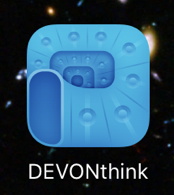

(Kourosh published a post that explains how to set up this integration.)Īn overview of the core of my current information garden. In other words, DEVONthink can work with files that reside outside its database.Īs you might have guessed, this can include Obsidian’s “vault.” (The folder where it keeps your notes.) Since both applications understand Markdown, you can view (and edit) your Obsidian notes using DEVONthink.

This is a powerful capability, especially if you’ve been collecting information for a long time.Īnother key DEVONthink feature - and the one that enables its interoperation with Obsidian - is its ability to index and manipulate items in folders in the computer’s filesystem.
Devonthink to go features pdf#
For example, you might be examining a blog post and realize there’s a PDF for an academic paper in your database that delves deeper into the same issue. (Of course, you can also sync this data over iCloud and such.)ĭEVONthink’s killer feature is its use of AI to spot relationships you may have missed between items in the database. As with Obsidian, DEVONthink runs and stores its data locally in your computer. There are a few similar applications in the market (most notably, Roam), but Obsidian’s key differentiator is that it stores notes in plaintext Markdown files in your computer’s filesystem (as opposed to a cloud-based server.)ĭEVONthink is an “everything bucket” application that allows you to save bookmarks, PDFs, images, and much else into databases where you can organize information in ways that suit you. Obsidian is a hypertext note-taking application. (My setup has been influenced by what I’ve seen other people doing - especially Andy Polaine and Kourosh Dini.) It’s a great combination because each app has strengths the other lacks, but both support Markdown text, so they can interoperate. Currently, I use DEVONthink as my primary storage/processing application, and Obsidian for taking notes.

But ultimately, everything gets digitized. I also write and sketch a lot in paper notebooks. For example, physical books are an important part of my information store. Much of this happens in software, but not all. Includes notes to self, meeting minutes, outlines, blog posts, etc. Includes links to web pages I’ve read (or need to read), PDFs from academic papers, books, audio/video files, etc.


 0 kommentar(er)
0 kommentar(er)
